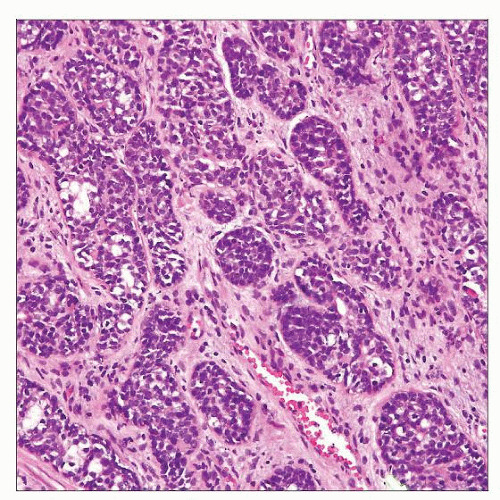Basal Cell and Adenoid Cystic Carcinoma
Rafael E. Jimenez, MD
Gladell P. Paner, MD
Mahul B. Amin, MD
Key Facts
Terminology
Malignant neoplasm composed primarily of basaloid cells arising putatively from prostatic basal cells
Clinical Issues
Wide age range (28-89 years), but majority occur in older men
Most commonly presents with obstructive urinary symptoms
Normal serum PSA level
Local recurrence, metastasis, and death from disease reported in approximately 30% of cases
Macroscopic Features
White and fleshy tumor with ill-defined infiltrative edges and may have microcystic features
Tumor primarily centered in transition zone, with variable peripheral zone involvement
Microscopic Pathology
Basaloid tumor cells have scant cytoplasm, high nuclear to cytoplasmic ratio, and irregular or angulated nuclei with open chromatin
Infiltration of adjacent parenchyma is hallmark feature for diagnosis of malignancy
2 main histologic patterns
BCC consisting of variably sized solid nests, cords, or trabeculae with peripheral palisading of cells
ACC consisting of infiltrative nests with prominent cribriform architecture
Ancillary Tests
Basal cell markers(+) and usually PSA/PSAP(-)
 BCC/ACC may present with 2 patterns. The BCC pattern is characterized by infiltrative solid nests of basaloid cells with peripheral cellular palisading, similar in appearance to cutaneous BCC. |
TERMINOLOGY
Abbreviations
Adenoid cystic carcinoma (ACC)
Basaloid cell carcinoma (BCC)
Synonyms
Adenoid basal cell tumor, adenoid cystic-like tumor
Definitions
Malignant neoplasm composed primarily of basaloid cells arising putatively from prostatic basal cells
ETIOLOGY/PATHOGENESIS
Origin
Considered to arise from basal cells along prostatic ducts and acini
CLINICAL ISSUES
Epidemiology
Incidence
Uncommon: Approximately < 75 cases reported in the literature
Age
Wide age range (28-89 years), but majority occur in older men
Presentation
Most commonly presents with obstructive urinary symptoms
Thus most cases diagnosed on transurethral resection of prostate (TURP) specimens
Perianal pain
Few tumors incidentally encountered in needle biopsy during work-up for elevated serum PSA level for other causes
Laboratory Tests
Serum PSA levels may be normal or elevated
Treatment
Most reported cases treated with TURP, with a subset undergoing radical prostatectomy
Advanced stage treated with adjuvant radiotherapy or chemotherapy
Prognosis
Limited data available on clinical behavior
Local recurrence, metastasis, and death from disease reported in approximately 30% of cases
Metastases commonly to lung and liver
Bone metastasis rare compared to acinar adenocarcinoma
Presence of large solid nests with central necrosis, high Ki-67 staining, and less immunoreactivity to basal cell markers suggested to be associated with aggressive behavior
MACROSCOPIC FEATURES
General Features
Grossly apparent tumor that is white and fleshy with ill-defined infiltrative edges
May have microcystic features
Site of Involvement
Tumor widely involving prostate, including peripheral zone
MICROSCOPIC PATHOLOGY
Histologic Features
Basaloid tumor cells have scant cytoplasm, high nuclear to cytoplasmic ratio, and irregular or angulated nuclei with open chromatin
Basaloid cells may exhibit nuclear and cytoplasmic microvacuolation
Infiltration of adjacent parenchyma is hallmark feature of BCC
BCC pattern
Variably sized solid nests, cords, or trabeculae with peripheral palisading of basaloid cells
May be associated with extensive central necrosis
ACC pattern
Tumor grows in nests with prominent cribriform architecture
Eosinophilic, hyaline, basement membrane-like material may be present
Basophilic mucinous secretions may be present in lumina
Additionally, tubuloglandular pattern with collagenous rim and basal cell hyperplasia-like patterns may occur
Combination of these different architectural patterns is often encountered
Usually associated with desmoplastic stromal response, which may be fibromyxoid or myxoid
Rarely acinar, sebaceous, or squamous cell differentiation may be present
Perineural invasion, angiolymphatic invasion, or necrosis may be present
Extraprostatic extension is often present, including involvement of bladder neck or seminal vesicle
Tumor involvement of thick bladder neck muscles detected with relatively high frequency in TURP specimens
Subset may have synchronous or metachronous prostate cancer, such as acinar adenocarcinoma, sarcomatoid carcinoma, or small cell carcinoma
Predominant Pattern/Injury Type
Neoplastic
Predominant Cell/Compartment Type
Epithelial




